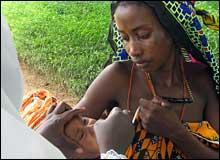Reaching them wherever they are - The boosting childhood immunity approach
27 January 2006 -- Abdullahi Wamzan, a community leader, watched with satisfaction as Attahiru Mohammed Chidawa, a trained health worker, vaccinated the children of Unguwan Magaji Lagan, a Kamberi Settlement in the Magama local government area (LGA) of Niger State. It was the first time ever that the community was hosting such an exercise to boost immunity in hard to reach areas among people who may not otherwise access immunization and other health services. The village elder admitted that his people do not normally go for routine immunization (RI) services at the clinic in Ibeto, 17 kilometres away, because despite suffering some measles deaths earlier in the year, distance is a challenge and the people do not have the funds to go there.
Following a sensitization visit to the local village elder, Chidawa, who on October 1, 2005 joined as one of six BCI vaccinators in the LGA, started the October 20 outreach by 6.30am, offering vaccinations for polio, measles, DPT, yellow fever and other routine antigens. He was calm as he waded through the tasks of constituting vaccines, injecting and recording.
Across the implementing states, the Boosting Childhood Immunity (BCI) approach is showing that efficient service delivery is possible. Many health workers selected as vaccinators on the initiative are proving that with basic motivation and needed guidance, better results can be achieved in routine immunization services and coverage. For example, in one of two rounds of BCI campaigns in Borno State, nearly 20,000 children were immunized with OPV, 10,000 for DPT1 and 27,564 were immunized against measles. Records like those at the Basic Health Centre, Salka, Niger State also show that between June and October, BCI mobile outreach services have consistently covered more children than the routine immunization services at the clinics. Apart from initial planning, which according to Dr Augustine Akubue of WHO, assured the line-listing of all settlements in catchment areas, BCI also supported the maintenance of settlement registers containing the names of those in communities including children and community leaders. Community leaders for example, are involved in the process of selecting focal persons who are health workers. As a result, more vaccinators have been recruited to ensure better coverage in the implementing LGAs.
In Kebbi State, a nomadic community approach is being undertaken, looking at the high risk areas. High risk areas are selected on the basis of where there are cases of wild polio virus. This indicates that children are continually being missed during supplementary immunization activities. Community mobilizers are used in these areas to assist with creating demand for immunization among these communities and to track defaulters.
The BCI is showing positive results. Migrant populations are now being reached through mobile outreach, as confirmed by Hussaini Ujila, Fulani Village Head of Banikusu, Shanga LGA. The discovery of a 5-month old zero-dose Aisha, whose mother was migrating to Birnin Yauri, Ngeski LGA and claimed not to have previously seen an immunization team, shows that BCI provides hope to many who may not otherwise access immunization services. The overall strengthening of static routine immunization centres combined with mobile outreach services offered through BCI will ensure that all eligible children are reached wherever they may be.
- By Nosa Owens-Ibie




